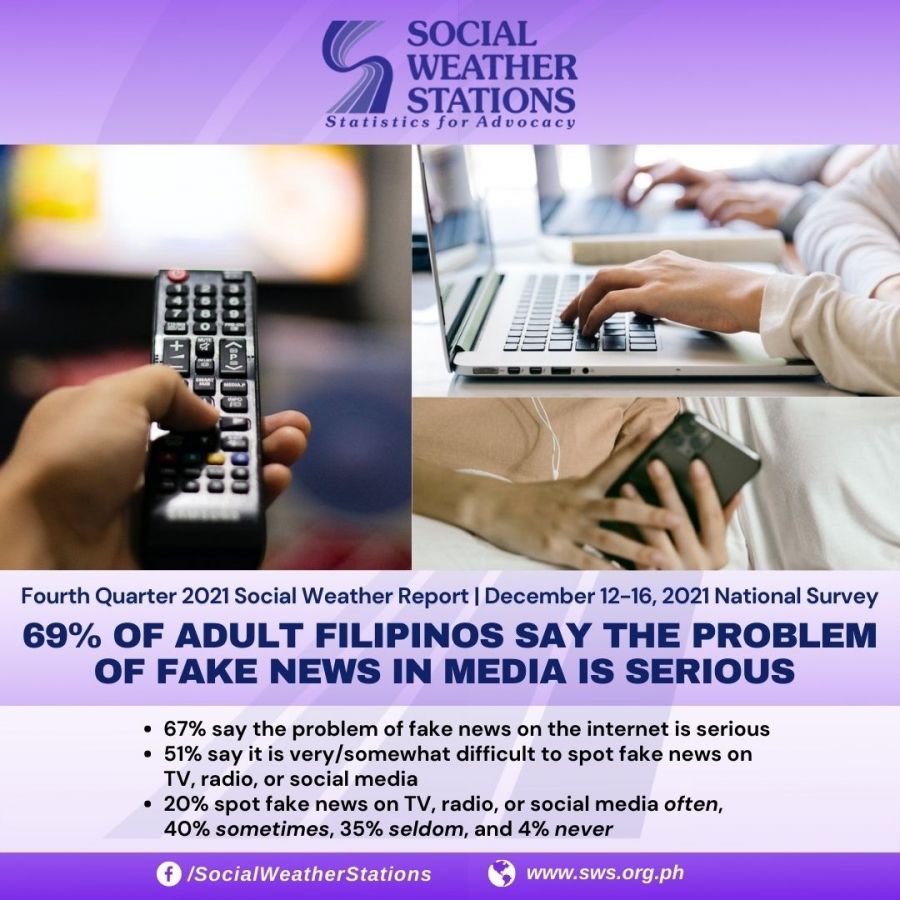
The December 2021 survey found 51% saying it is difficult (consisting of 13% very difficult and 38% somewhat difficult) for them to know if a piece of news or information from the television, radio, or social media is fake or wrong, while 48% consider it easy (consisting of 37% somewhat easy and 11% very easy)
By Social Weather Station
Fourth Quarter 2021 Social Weather Survey: 69% of adult Filipinos say the problem of fake news in media is serious
- 67% say the problem of fake news on the internet is serious
- 51% say it is very/somewhat difficult to spot fake news on TV, radio, or social media
- 20% spot fake news on TV, radio, or social media often, 40% sometimes, 35% seldom, and 4% never
The national Social Weather Survey of December 12–16, 2021, found 69% of adult Filipinos (correctly rounded) saying the problem of fake news in media is serious.
The survey question was, “In your opinion, how serious is the problem of the spread of fake news in MEDIA like television, radio, and newspaper?”
To this, 32% answered very serious, 38% somewhat serious, 21% were undecided, 6% answered somewhat not serious, and 3% not serious at all [Chart 1].
Compared to December 2017, those who consider the problem of fake news in media as serious (% very serious and % somewhat serious) rose by 9 points from 60% (29% very serious, 31% somewhat serious).
67% say the problem of fake news on the internet is serious
On fake news on the internet, the question was, “In your opinion, how serious is the problem of the spread of fake news on the INTERNET like in Facebook, Twitter, and Youtube?”
To this, 32% answered very serious, 35% somewhat serious, 24% were undecided, 5% answered somewhat not serious, and 3% not serious at all.
The December 2021 percentage of those who consider the problem of fake news on the internet as serious is similar to the 67% (40% very serious, 26% somewhat serious, correctly rounded) in March 2018, but is 9 points above the 58% (32% very serious, 26% somewhat serious) in December 2017.
51% say it is very/somewhat difficult to spot fake news on TV, radio, or social media
The December 2021 survey found 51% saying it is difficult (consisting of 13% very difficult and 38% somewhat difficult) for them to know if a piece of news or information from the television, radio, or social media is fake or wrong, while 48% consider it easy (consisting of 37% somewhat easy and 11% very easy) [Chart 2].
20% spot fake news on TV, radio, or social media often, 40% sometimes, 35% seldom, and 4% never
The December 2021 survey also found 20% saying they see or read fake or wrong information on television, radio, or social media often, 40% sometimes, 35% seldom, and 4% never [Chart 3].
The problem of fake news is considered more serious by those who can easily spot them
Those who consider the problem of fake news in media as serious (% very serious and % somewhat serious) are higher among those who say spotting fake news is very easy (82%) and somewhat easy (78%) than among those who say spotting fake news is somewhat difficult (62%) and very difficult (58%) [Chart 4].
Similarly, those who consider the problem of fake news on the internet as serious are higher among those who say spotting fake news is very easy (79%) and somewhat easy (74%) than among those who say spotting fake news is somewhat difficult (60%, correctly rounded) and very difficult (60%) [Chart 5].
The problem of fake news is considered more serious by those who spot them more often
Those who consider the problem of fake news in media as serious are highest among those who see or read fake news on television, radio, or social media often (84%), followed by those who encounter fake news sometimes (76%), and seldom (57%) [Chart 6].
Among those who say they never see or read fake news on television, radio, or social media, 30% consider the problem of fake news in media as serious.
On the other hand, those who say the problem of fake news on the internet is serious are highest among those who see or read fake news on television, radio, or social media often (82%), followed by those who spot fake news sometimes (73%) and seldom (55%) [Chart 7].
Among those who say they never see or read fake news on television, radio, or social media, 31% consider the problem of fake news on the internet as serious.
The problem of fake news in media worsens in all areas
The percentage of those who consider the problem of fake news in media as serious is highest in Metro Manila (79%, correctly rounded), followed by Balance Luzon (71%, correctly rounded), Mindanao (65%), and the Visayas (63%) [Chart 8].
Compared to December 2017, those who say the problem of fake news in media is serious rose by 11 points from 68% in Metro Manila, by 10 points from 61% in Balance Luzon, by 4 points from 61% in Mindanao, and by 12 points from 51% in the Visayas.
The problem of fake news on the internet worsens in Metro Manila and Mindanao
Those who consider the problem of fake news on the internet as serious are highest in Metro Manila (80%), followed by Balance Luzon (66%), the Visayas (63%, correctly rounded), and Mindanao (62%) [Chart 9].
Compared to March 2018, those who consider the problem of fake news on the internet as serious rose by 9 points from 71% in Metro Manila and by 10 points from 52% in Mindanao.
However, it fell by 5 points from 71% in Balance Luzon and by 5 points from 68% in the Visayas.
In all areas, the latest percentages of those who say the problem of fake news on the internet is serious are higher than those in December 2017.
The problem of fake news is considered more serious by those with higher education
Those who say the problem of fake news in media is serious are higher among college graduates (74%) and junior high school graduates (75%) than among elementary graduates (63%) and non-elementary graduates (54%) [Chart 10].
Compared to December 2017, the percentage of those who consider the problem of fake news in media as serious rose by 4 points from 70% among college graduates, by 11 points from 64% among junior high school graduates, and by 11 points from 52% among elementary graduates. It stayed at 54% among non-elementary graduates.
On the other hand, those who say the problem of fake news on the internet is serious are also higher among college graduates (75%) and junior high school graduates (74%) than among elementary graduates (59%) and non-elementary graduates (48%) [Chart 11].
Compared to March 2018, the percentage of those who consider the problem of fake news on the internet as serious hardly changed from 76% among college graduates.
It rose by 7 points from 67% (correctly rounded) among junior high school graduates and by 5 points from 54% (correctly rounded) among elementary graduates.
However, it fell by 12 points from 60% among non-elementary graduates.
In all educational levels, the December 2021 percentages of those who consider the problem of fake news on the internet as serious are higher than those in December 2017.
About 1/2 in all areas say it is difficult to spot fake news on TV, radio, or social media
The percentage of those who consider it difficult (% very difficult and % somewhat difficult) to spot fake news on television, radio, or social media is highest in Mindanao (54%, correctly rounded), followed by Balance Luzon (52%), the Visayas (50%), and Metro Manila (47%, correctly rounded) [Chart 12].
Spotting fake news is more difficult among the less educated
The percentage of those who consider it difficult to spot fake news on television, radio, or social media is highest among non-elementary graduates (59%), followed by elementary graduates (58%), junior high school graduates (48%), and college graduates (43%, correctly rounded) [Chart 13].
Spotting fake news is most frequent in Metro Manila and among the more educated groups
The percentage of those who say they often spot fake news on television, radio, or social media is highest in Metro Manila (34%), followed by Balance Luzon (23%), the Visayas (15%), and Mindanao (11%) [Chart 14].
By education, it is highest among college graduates (26%), followed by junior high school graduates (23%), elementary graduates (17%), and non-elementary graduates (13%) [Chart 15].
Socio-demographic characteristics of respondents
Applying census weights, 13% of the respondents are from Metro Manila, 45% from Balance Luzon (or Luzon outside Metro Manila), 19% from the Visayas, and 23% from Mindanao [Table 1].
Forty-eight percent are from urban areas, and the balance of 52% are from rural areas.
Male and female respondents have a 1 to 1 ratio, and thus, are alternately sampled.
By age group, 12% are youth (18-24), 19% are intermediate youth (25-34), 21% are middle-aged (35-44), 19% are 45 to 54 years old, and 29% are 55 years old and above.
By education, 13% had at most some elementary education, 26% either finished elementary or had some high school education, 48% either finished high school, completed vocational school, or attended some college, and 13% either graduated from college or took post-graduate studies.
Survey background
The Fourth Quarter 2021 Social Weather Survey was conducted from December 12-16, 2021, using face-to-face interviews of 1,440 adults (18 years old and above) nationwide: 360 each in Balance Luzon, Metro Manila, the Visayas, and Mindanao. Face-to-face is the standard interviewing method for Social Weather Stations; the only exceptions were early in the pandemic when movement restrictions made face-to-face impossible and mobile phone interviews were conducted. Normal face-to-face field operations resumed in November 2020. The sampling error margins are ±2.6% for national percentages and ±5.2% for Balance Luzon, Metro Manila, the Visayas, and Mindanao.
The area estimates were weighted by the Philippine Statistics Authority medium-population projections for 2021 to obtain the national estimates.
The survey items reported here were non-commissioned. They were done on SWS’s own initiative and released as a public service. The findings were first presented at the annual SWS Survey Review on February 7, 2021.
The exact phrasing of the survey questions (the source language is Filipino; English translation included) was:
“Q169. Sa inyong palagay, gaano ka-seryoso ang problema ng pagkalat ng mga pekeng balita sa MEDIA tulad ng telebisyon, radyo, at pahayagan? (SHOW CARD: TALAGANG SERYOSO; MEDYO SERYOSO; HINDI TIYAK KUNG SERYOSO O HINDI SERYOSO; MEDYO HINDI SERYOSO; TALAGANG HINDI SERYOSO) [In your opinion, how serious is the problem of the spread of fake news in MEDIA like television, radio, and newspapers? (SHOW CARD: Very serious; Somewhat serious; Undecided if serious or not serious; Somewhat not serious; Not serious at all)]
“Q170. Sa inyong palagay, gaano ka-seryoso ang problema ng pagkalat ng mga pekeng balita sa INTERNET tulad sa Facebook, Twitter, at Youtube? (SHOW CARD: TALAGANG SERYOSO; MEDYO SERYOSO; HINDI TIYAK KUNG SERYOSO O HINDI SERYOSO; MEDYO HINDI SERYOSO; TALAGANG HINDI SERYOSO) [In your opinion, how serious is the problem of the spread of fake news on the INTERNET like in Facebook, Twitter, and Youtube? (SHOW CARD: Very serious; Somewhat serious; Undecided if serious or not serious; Somewhat not serious; Not serious at all)]
“Q171. Base po sa inyong kakayahan, sa palagay po ninyo (SHOW CARD: TALAGANG MADALI; MEDYO MADALI; MEDYO MAHIRAP; TALAGANG MAHIRAP) para malaman ninyo kung ang isang balita o impormasyon na inyong pinapanood, naririnig o binabasa sa TV, radyo o social media ay peke o mali. [Based on your ability, you think (SHOW CARD: Very easy; Somewhat easy; Somewhat difficult; Very difficult) to know if a piece of news or information that you watch, hear or read on TV, radio or social media is fake or wrong?]
“Q172. Gaano kadalas po kayo nakakakita o nakakabasa ng mga balita o impormasyong sa TV, radyo, o social media na peke o mali? (SHOW CARD: MADALAS; PAMINSAN-MINSAN; BIHIRA; HINDI KAILANMAN) [How often do you see or read news or information on TV, radio, or social media that is fake or wrong? (SHOW CARD: Often; Sometimes; Seldom; Never)]”
SWS employs its own staff for questionnaire design, sampling, fieldwork, data processing, and analysis and does not outsource any of its survey operations. This report was prepared by Leo S. Laroza and Marvin R. Ipac.
Chart 1
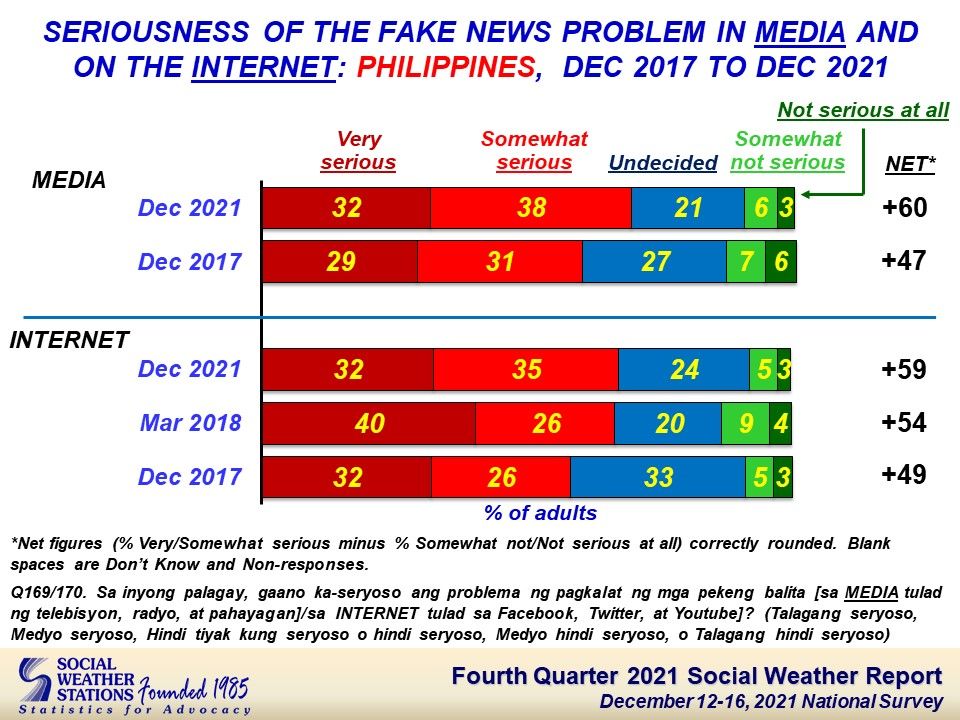
Chart 2
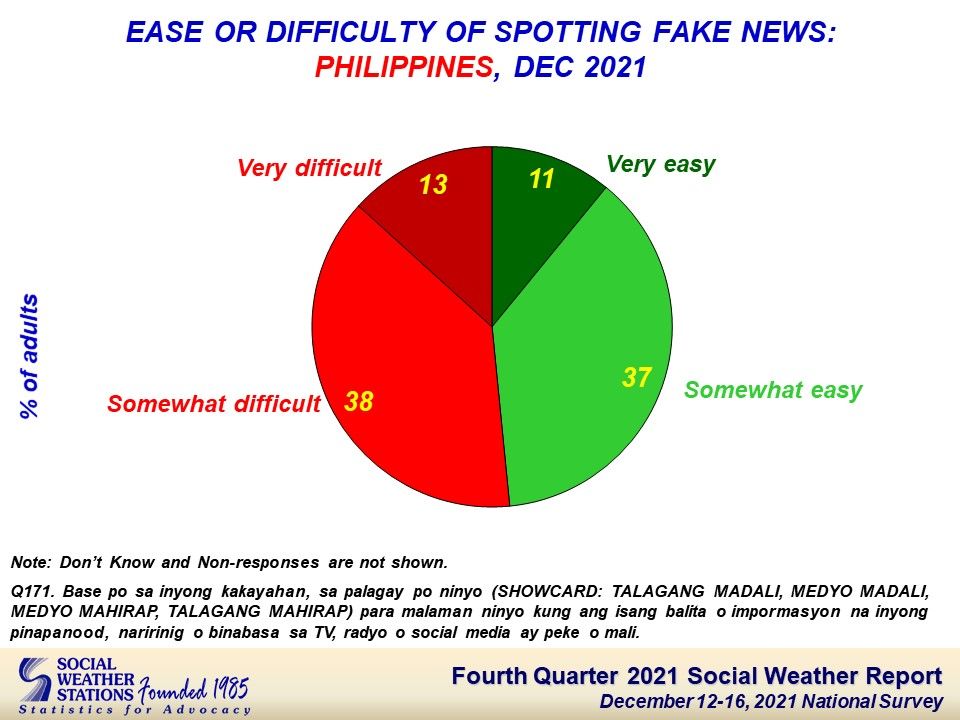
Chart 3
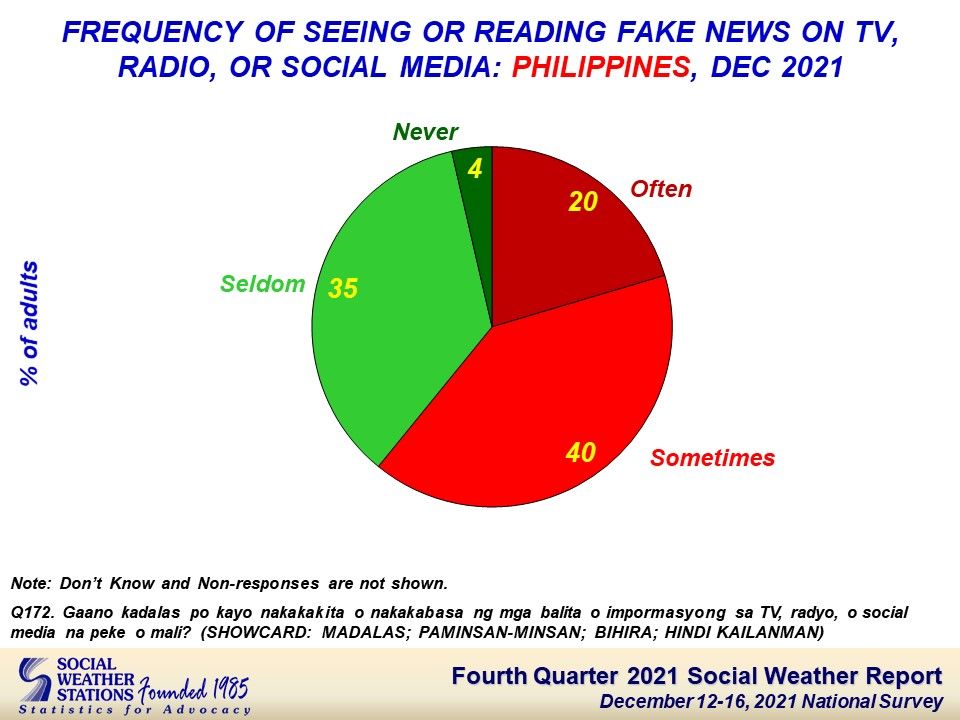
Chart 4
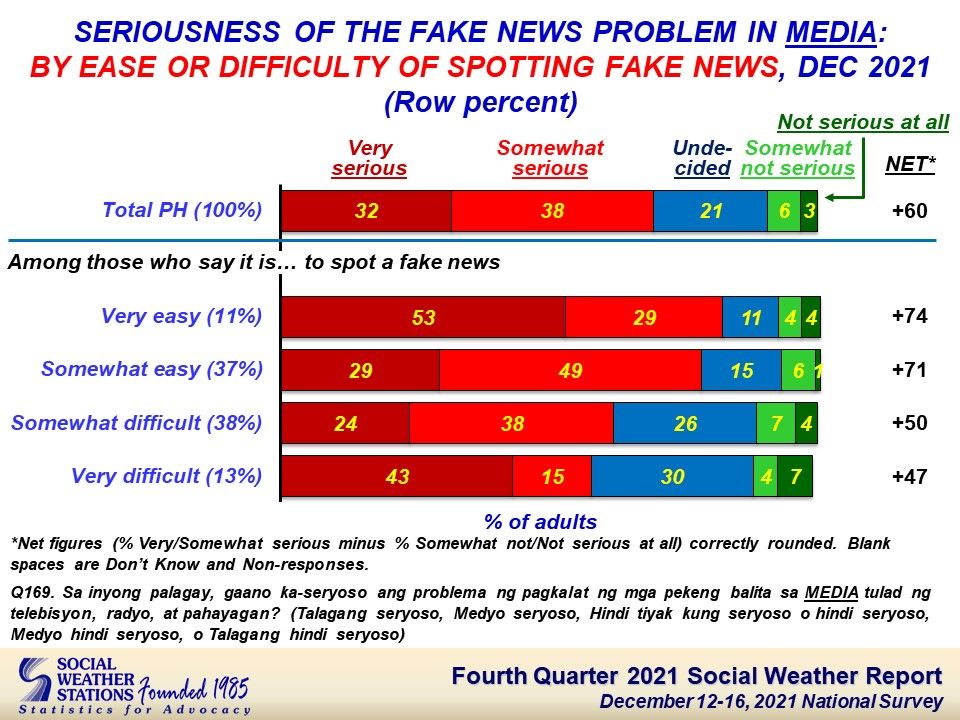
Chart 5
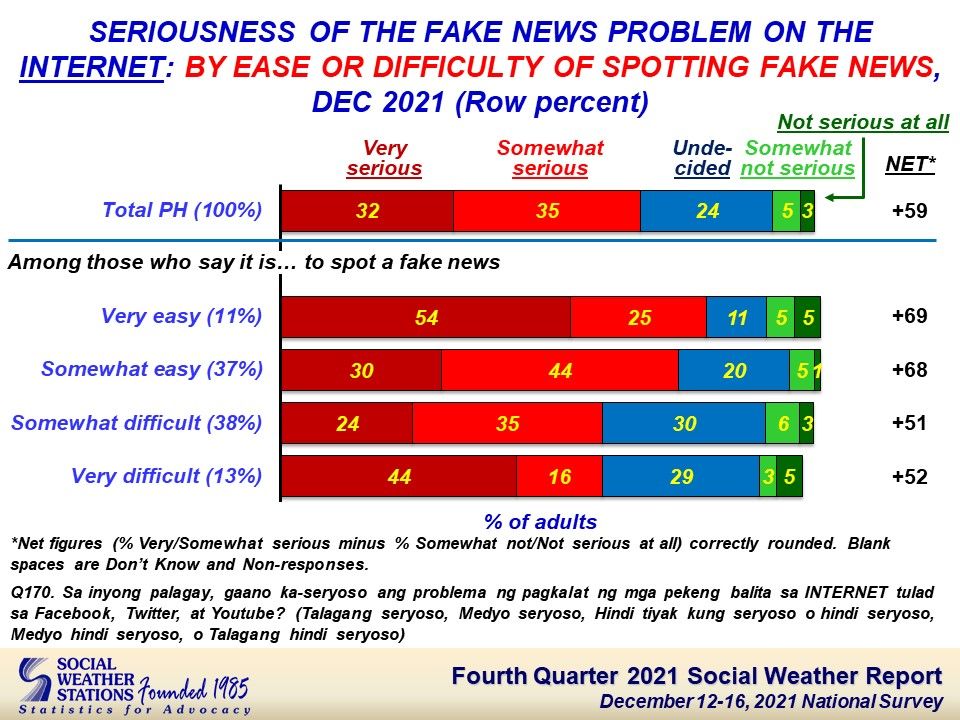
Chart 6
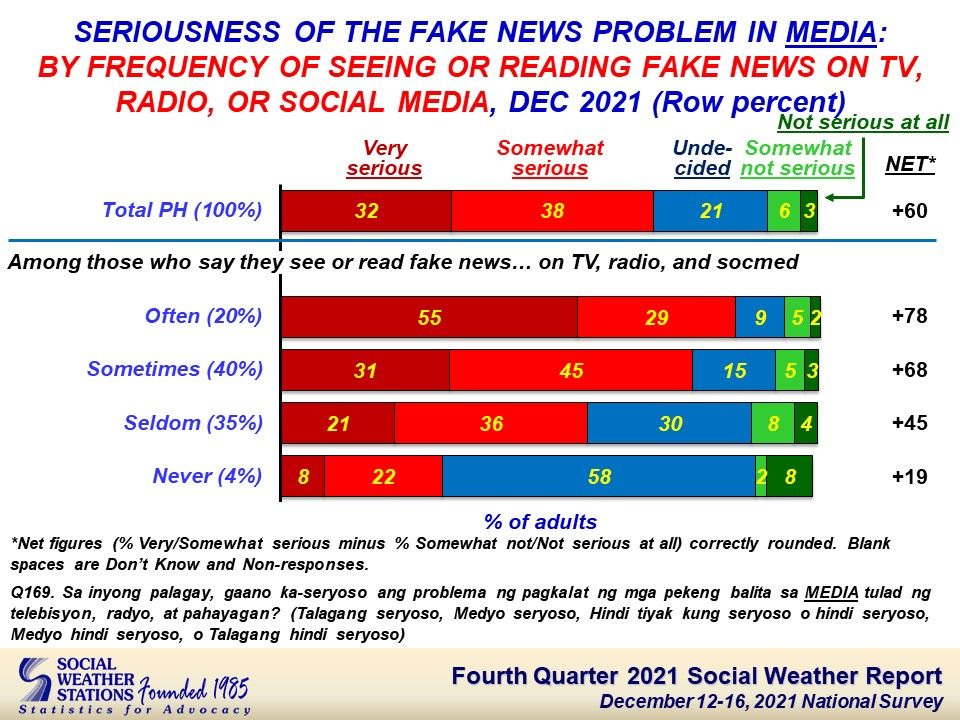
Chart 7
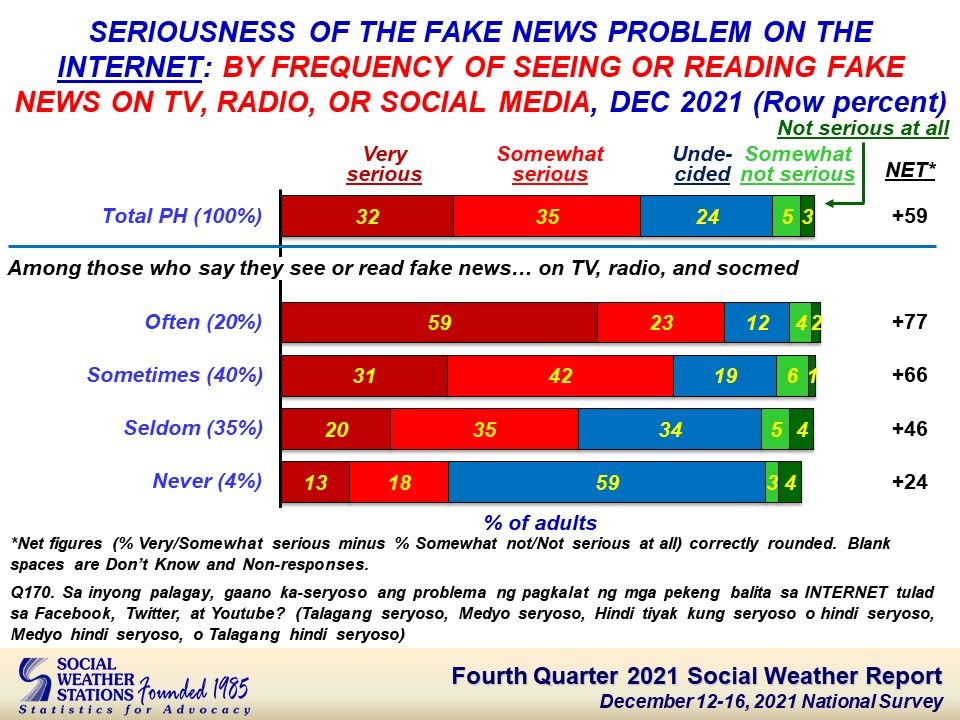
Chart 8
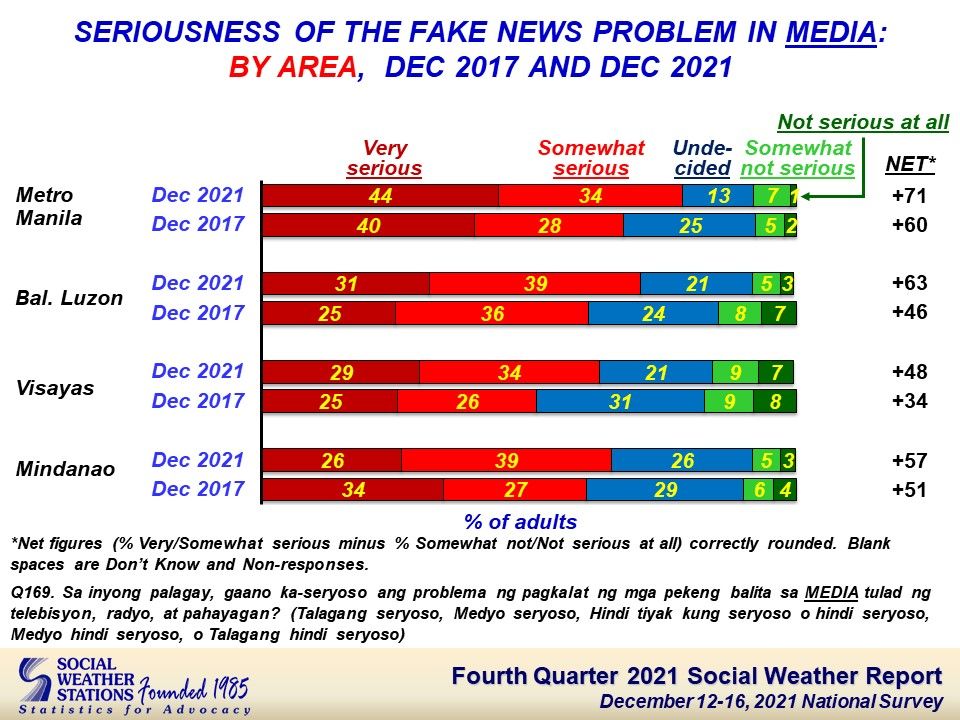
Chart 9
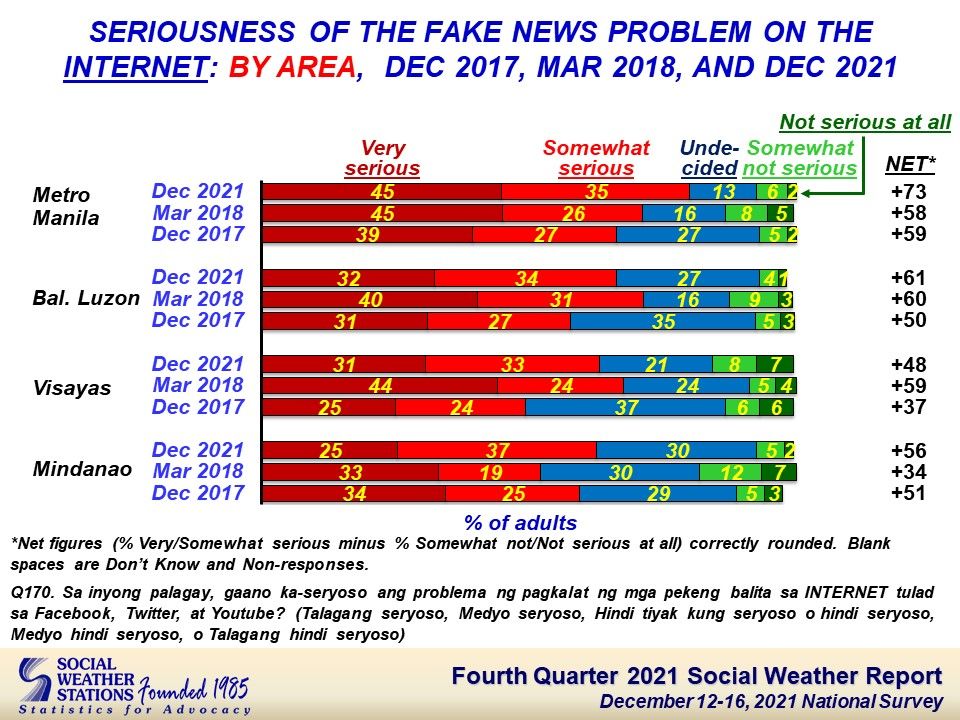
Chart 10
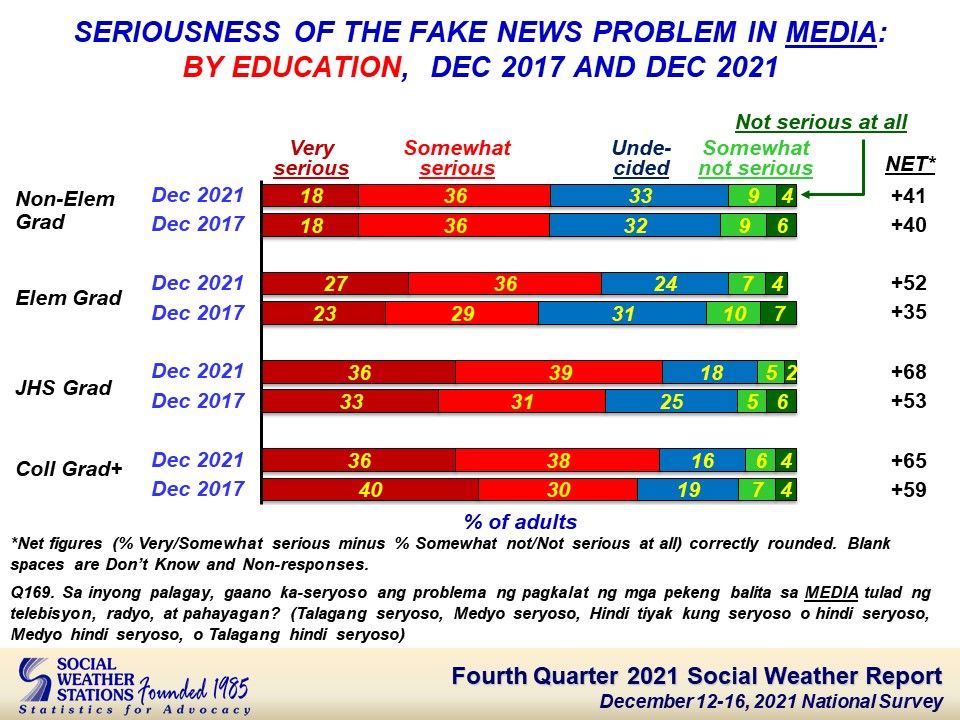
Chart 11
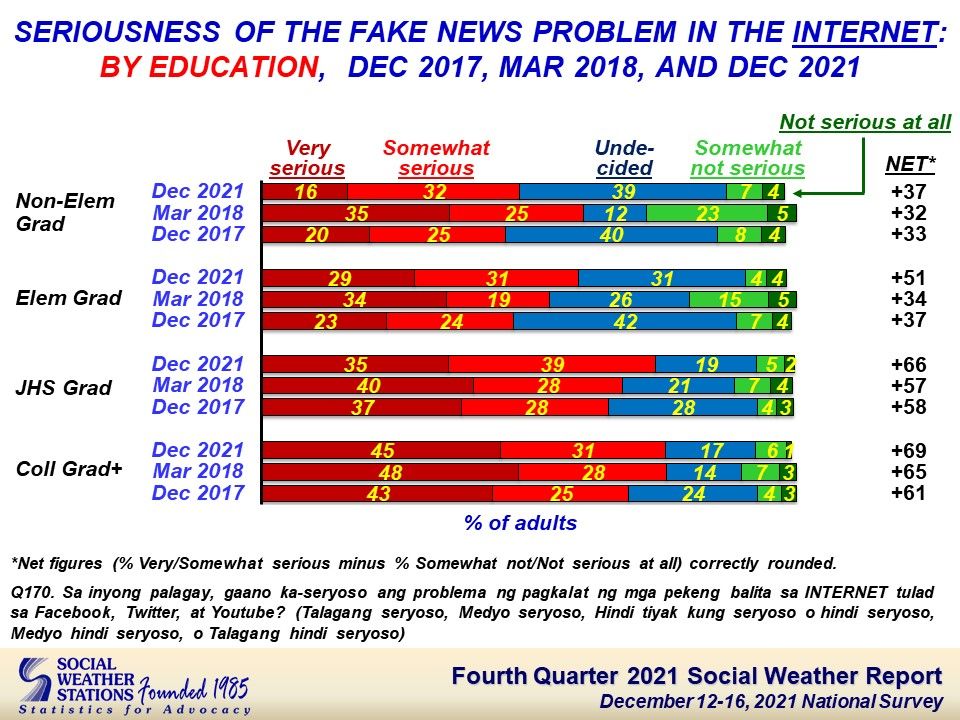
Chart 12
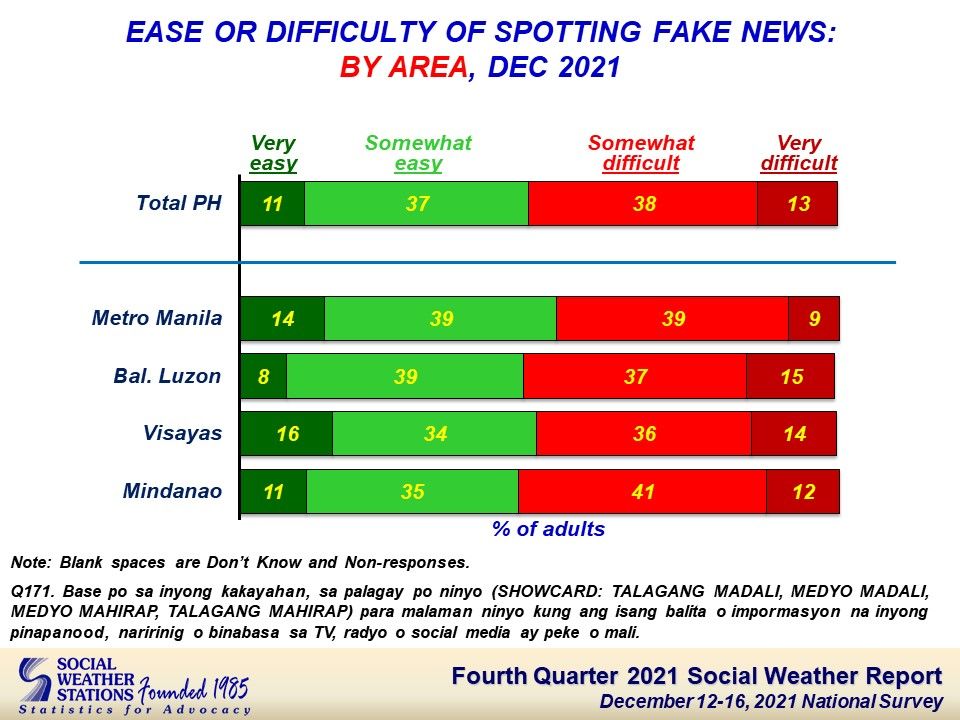
Chart 13
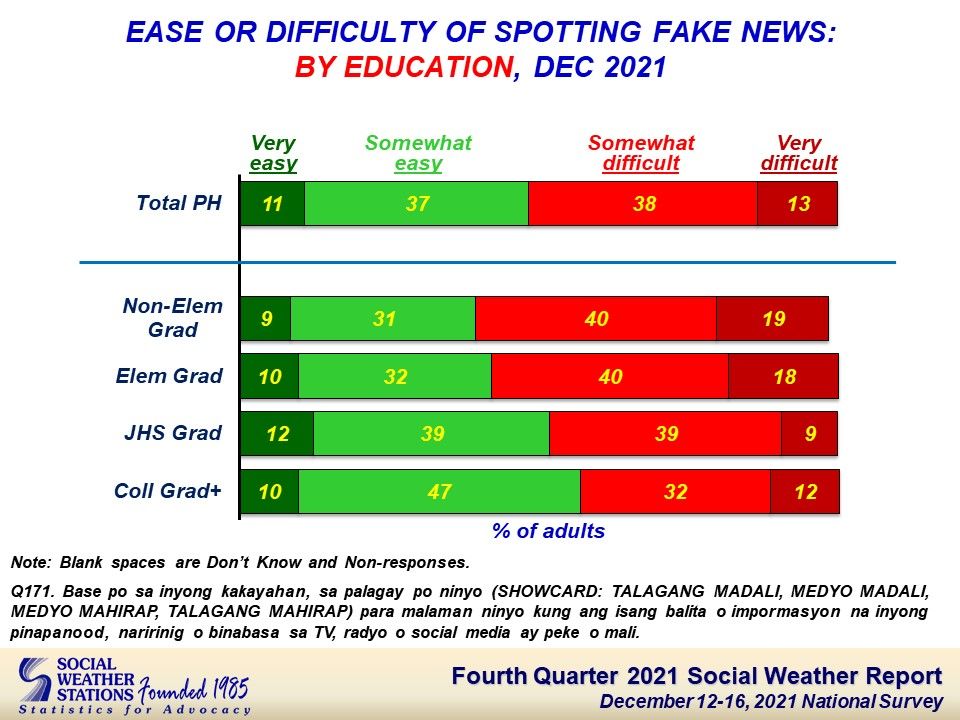
Chart 14
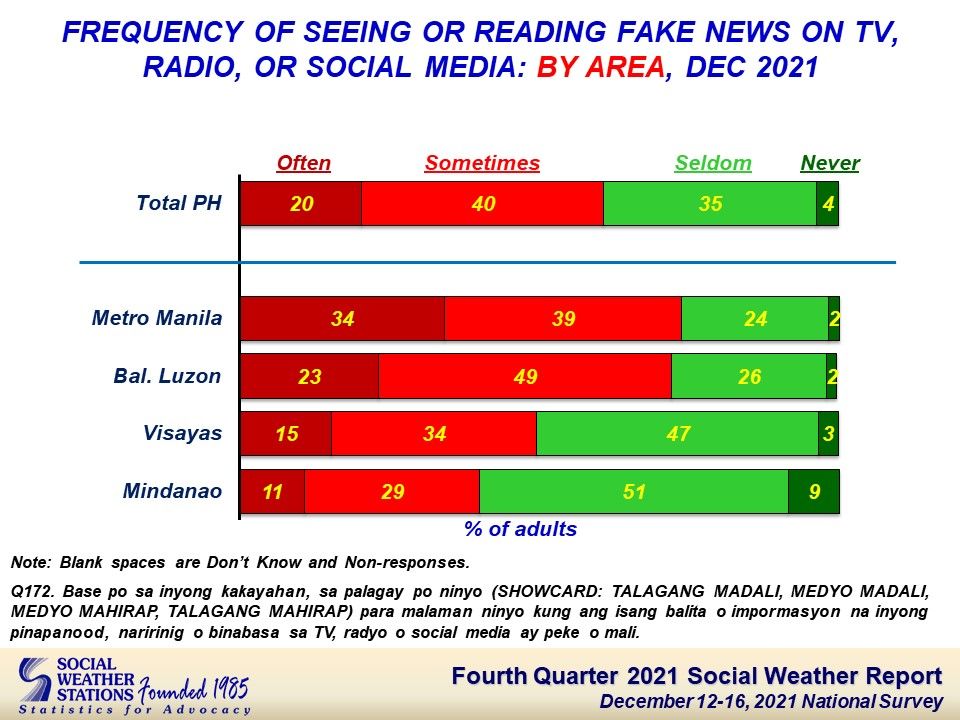
Chart 15
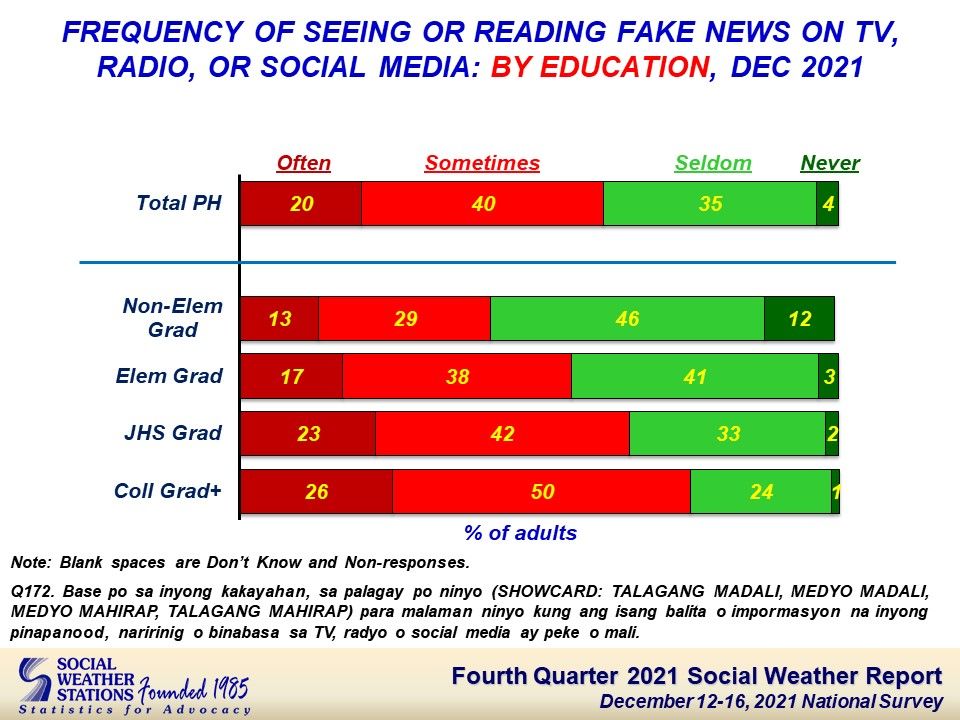
Table 1
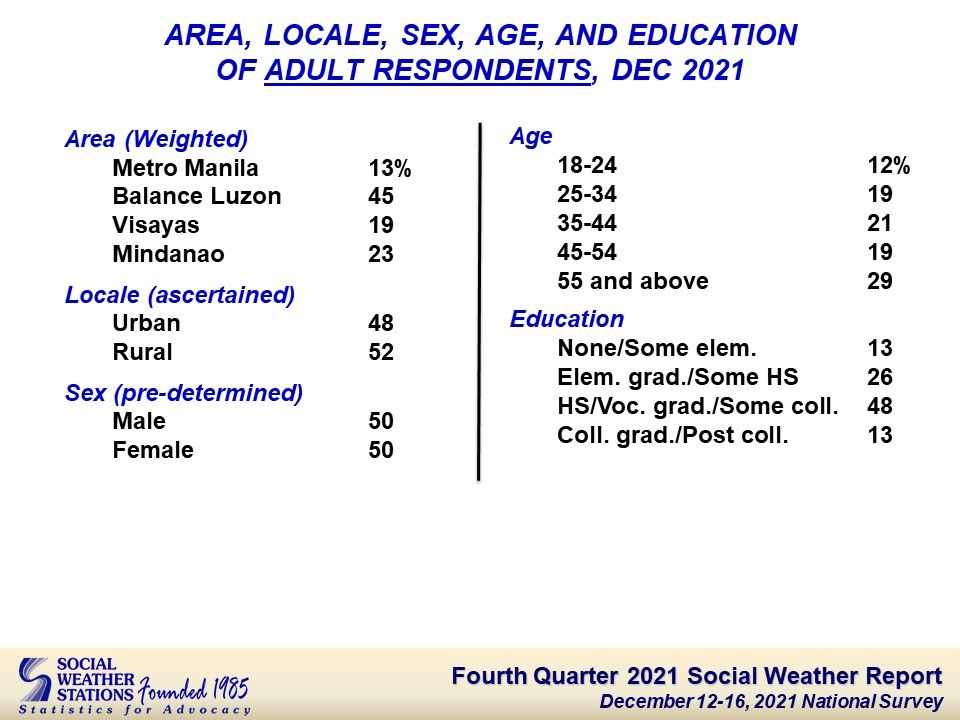
If you liked what you just read and want more of Our Brew, subscribe to get notified. Just enter your email below.

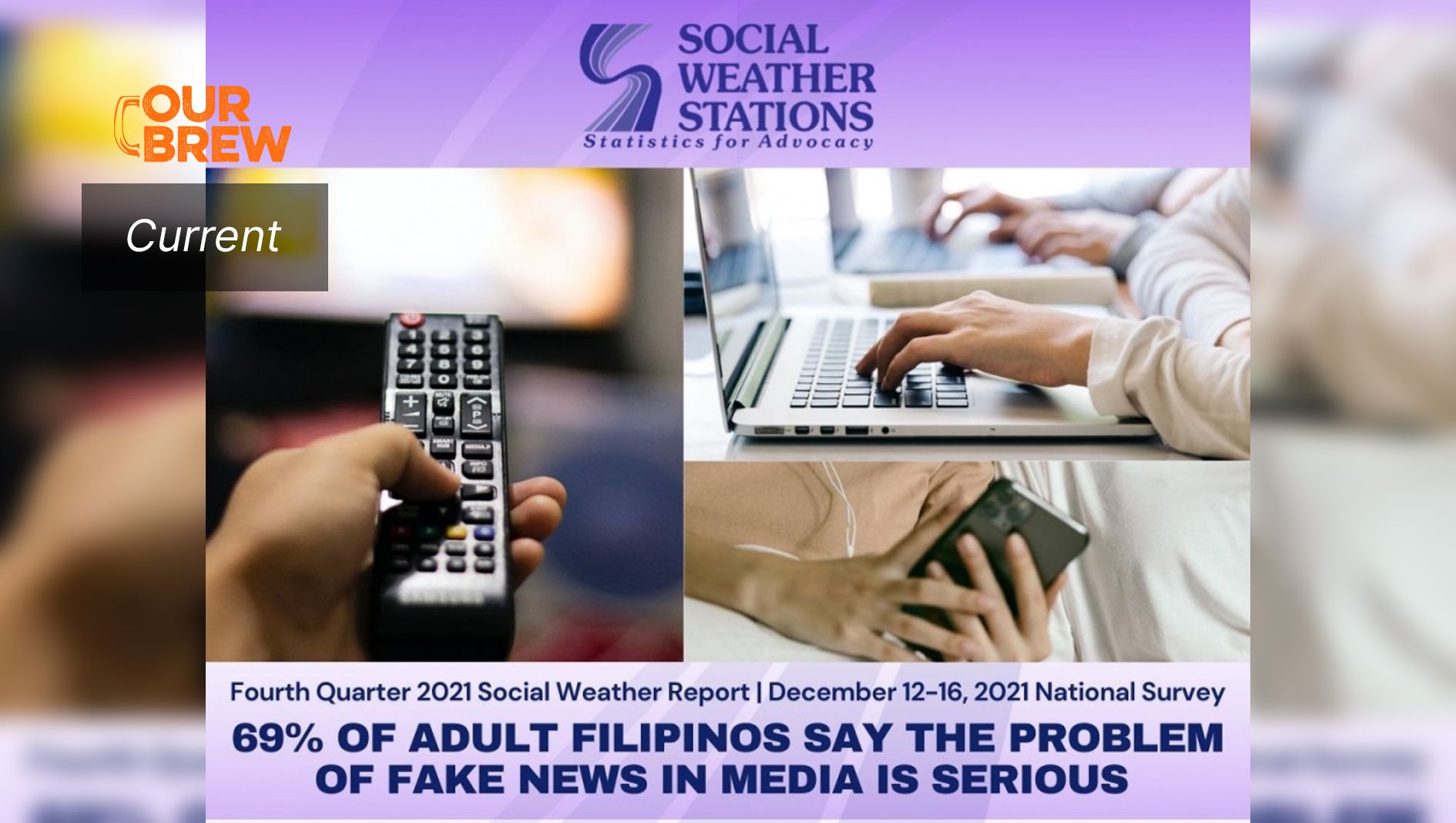
Related Posts
Social Weather Report | 59% Knew of VP Sara Duterte’s Fourth Impeachment Case Before the Survey; 41% Learned Only During the Interview
Jul 09, 2025
Supreme Court Rules Trump Can Rapidly Deport Immigrants to Libya, South Sudan and Other Countries They Aren’t From
Jun 25, 2025
Israel, Iran and the US: Why 2025 is a Turning Point for the International Order
Jun 19, 2025